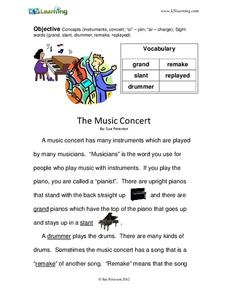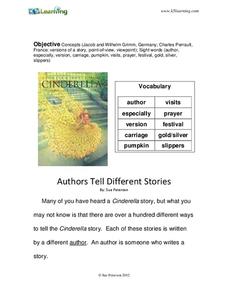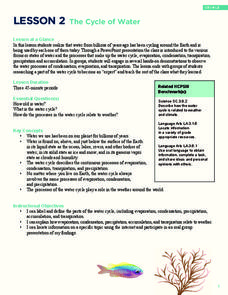K5 Learning
Robert Fulton – Steamboat Inventor
Examine the life of steamboat inventor, Robert Fulton, through reading comprehension worksheet that includes both multiple choice and short answer questions. Then, take part in a word search and write definitions, words, and sentences...
K5 Learning
Rhyming Animals
Second graders read an informational text passage on animals, as well as a poem that incorporates rhyming words. Then, 2nd graders answer questions based on what they read.
K5 Learning
The Music Concert
Second graders read an informational text passage on music concerts and then answer questions based on what they read.
K5 Learning
The Day I Tried to Cook
First graders read a short story on cooking. Then they respond to questions based on interest and practice writing.
K5 Learning
The Moon
Second graders read a short informational text passage about the moon and answer a series of questions based on what they read.
K5 Learning
The Great Sphinx Statue
Second graders read an informational text passage on the Great Sphinx, and answer questions based on what they read.
K5 Learning
Fight for Equality: Thurgood Marshall
Students read an informational text passage on Thurgood Marshall and his contribution to African Americans' rights, and then answer questions based on what they read.
K5 Learning
Authors Tell Different Stories
The story of Cinderella is a popular one! So much so, there are multiple versions of the story being told around the world. With this collection of activities your young readers receive background information about two versions...
Ed Worksheets
Read the Story
Want to boost your readers' comprehension skills and strategies? Look to these five pages, each with a short story and questions to answer covering main idea, facts, sequence of events, context clues, conclusions, and making inferences.
Common Core Sheets
Finding Area
Practice makes proficient! Here, 10 versions make up an area instructional activity in which mathematicians find the area rectangles and squares in centimeters.
Random House
Mapping Skills
Spark interest and enhance your pupils' map skills using Matteo Pericoli's book, See the City: the Journey of Manhattan Unfurled. Through Pericoli's illustrations and text, learners explore the East and West side of Manhattan. Then,...
Math Drills
Santa's List Sums (F2)
Help Santa find the sum of the boys and girls that live on each street.
NOAA
The Cycle of Water
Young water cycle enthusiasts discover the water they have been using has been cycling around the earth for billions of years. Through presentations, learners will understand that water has three states and how these forms fit into the...
NASA
The Case of the Wacky Water Cycle
Join the tree house detectives in learning about the processes of the water cycle, water conservation, water treatment, and water as a limited resource.
K-5 Math Teaching Resources
Base Ten Mat (Tens and Ones)
When working with base blocks, you need a base ten mat. Well, here it is! Organize your tens and ones using this mat to represent, count, and examine numbers.
K-5 Math Teaching Resources
Base Ten Mat (Tens and Ones with Tens Frame)
Working with base 10 blocks? Use this base 10 mat to organize blocks, tens and ones with one ten frame, and determine how many groups of blocks can be used to represent numbers.
Math Drills
Valentine's Day Ordering and Comparing (B)
Discover this Valentine's Day-themed worksheet where young mathematicians answer word problems using data tables.
Math Drills
Valentine's Day Ordering and Comparing (A)
Youngsters use a data table to answer questions, in a Valentine's Day-themed worksheet.
Learner
Solid Shapes
A collection of two lessons, kindergartners will identify two-dimensional shapes in solid shapes. They will develop basic knowledge of the components that make up a sphere, rectangular prism, pyramid, cylinder, cone, and cube. Young...
Dawn N . Ericson
California Kelp Forest Restoration
This unit is so cool, you won't be able to "kelp" yourself! Intended for all grades, this science and activity guide for teachers offers a unique opportunity to understand kelp's role as a valuable ecological resource. Teachers and...
World Wildlife Fund
Arctic Take 6
The magic number is six! Using a 6x table, young math stars practice adding, subtracting, multiplying, and dividing two-digit numbers with the number six. This worksheet also touches on making tessellations with hexagons.
K12 Reader
St. Patrick’s Day Words
A St. Patrick's Day-themed learning exercise invites young leprechauns to match the word with its meaning by writing the corresponding letter in the blank. There are 10 words and definitions that are connected to Ireland. Lastly, pupils...
Teacher's Guide
Two Digit Subtraction with Regrouping
Second and third graders are prompted to find the differences of two-digit equations with regrouping. Encourage your class to show their work using models or drawings.
Teacher's Guide
Two-Digit Subtraction Without Regrouping
Youngsters are prompted to find the differences in two-digit numbers without regrouping. There are 15 equations to solve.

























